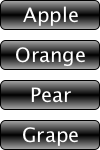A QML document is a block of QML source code. QML documents generally correspond to files stored on a disk or at a location on a network, but they can also be constructed directly from text data.
Here is a simple QML document:
import QtQuick 1.0 Rectangle { width: 240; height: 320; resources: [ Component { id: contactDelegate Text { text: modelData.firstName + " " + modelData.lastName } } ] ListView { anchors.fill: parent model: contactModel delegate: contactDelegate } }
QML documents are always encoded in UTF-8 format.
A QML document always begins with one or more import statements. To prevent elements introduced in later versions from affecting existing QML programs, the element types available within a document are controlled by the imported QML 模块 . That is, QML is a versioned 语言。
Syntactically a QML document is self contained; QML does
not
have a preprocessor that modifies the document prior to presentation to the QML runtime.
import
statements do not "include" code in the document, but instead instruct the QML runtime on how to resolve type references found in the document. Any type reference present in a QML document - such as
Rectangle
and
ListView
- including those made within an
JavaScript block
or
特性绑定
s, are
resolved
based exclusively on the import statements. QML does not import any modules by default, so at least one
import
statement must be present or no elements will be available!
每个
id
value in a QML document must be unique within that document. They do not need to be unique across different documents as id values are resolved according to the document scope.
A QML document defines a single, top-level QML component . A QML component is a template that is interpreted by the QML runtime to create an object with some predefined behaviour. As it is a template, a single QML component can be "run" multiple times to produce several objects, each of which are said to be instances of the component.
Once created, instances are not dependent on the component that created them, so they can operate on independent data. Here is an example of a simple "Button" component (defined in a
Button.qml
file) that is instantiated four times by
application.qml
. Each instance is created with a different value for its
text
特性:
| Button.qml | application.qml |
import QtQuick 1.0 Rectangle { property alias text: textItem.text width: 100; height: 30 border.width: 1 radius: 5 smooth: true gradient: Gradient { GradientStop { position: 0.0; color: "darkGray" } GradientStop { position: 0.5; color: "black" } GradientStop { position: 1.0; color: "darkGray" } } Text { id: textItem anchors.centerIn: parent font.pointSize: 20 color: "white" } } |
import QtQuick 1.0 Column { spacing: 10 Button { text: "Apple" } Button { text: "Orange" } Button { text: "Pear" } Button { text: "Grape" } } 
|
Any snippet of QML code can become a component, just by placing it in the file "<Name>.qml" where <Name> is the new element name, and begins with an uppercase letter. Note that the case of all characters in the <Name> are significant on some filesystems, notably UNIX filesystems. It is recommended that the case of the filename matches the case of the component name in QML exactly, regardless of the platform the QML will be deployed to.
These QML component files automatically become available as new QML element types to other QML components and applications in the same directory.
In addition to the top-level component that all QML documents define, and any reusable components placed in separate files, documents may also include
inline
components. Inline components are declared using the
Component
element, as can be seen in the first example above. Inline components share all the characteristics of regular top-level components and use the same
import
list as their containing QML document. Components are one of the most basic building blocks in QML, and are frequently used as "factories" by other elements. For example, the
ListView
element uses the
delegate
component as the template for instantiating list items - each list item is just a new instance of the component with the item specific data set appropriately.
Like other
QML 元素
,
Component
element is an object and must be assigned to a property.
Component
objects may also have an object id. In the first example on this page, the inline component is added to the
Rectangle
's
resources
list, and then
特性绑定
is used to assign the
Component
到
ListView
's
delegate
property. While using property binding allows the
Component
object to be shared (for example, if the QML document contained multiple
ListView
's with the same delegate), in this case the
Component
could have been assigned directly to the
ListView
's
delegate
. The QML language even contains a syntactic optimization when assigning directly to a component property for this case where it will automatically insert the
Component
标签。
These final two examples are behaviorally identical to the original document.
import QtQuick 1.0 Rectangle { width: 240; height: 320; ListView { anchors.fill: parent model: contactModel delegate: Component { Text { text: modelData.firstName + " " + modelData.lastName } } } } |
import QtQuick 1.0 Rectangle { width: 240; height: 320; ListView { anchors.fill: parent model: contactModel delegate: Text { text: modelData.firstName + " " + modelData.lastName } } } |
另请参阅 QDeclarativeComponent .